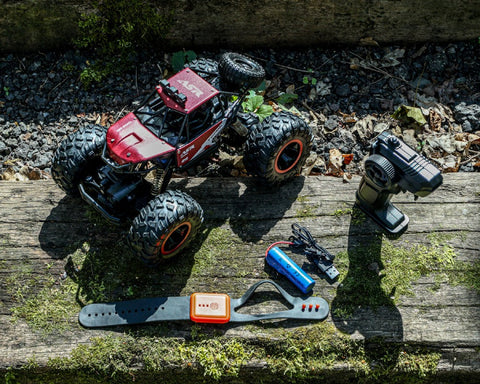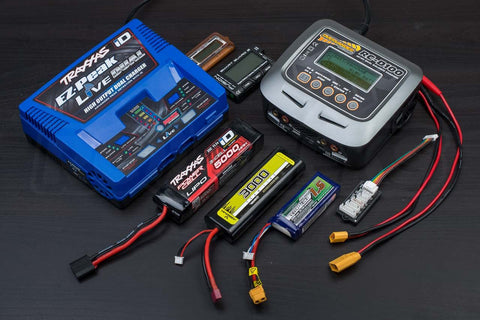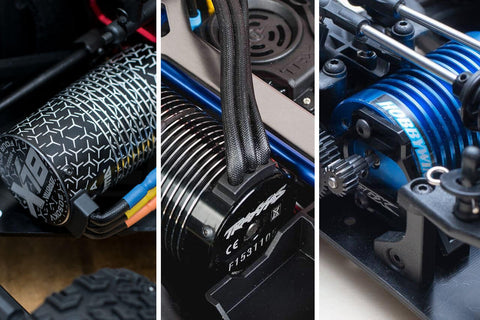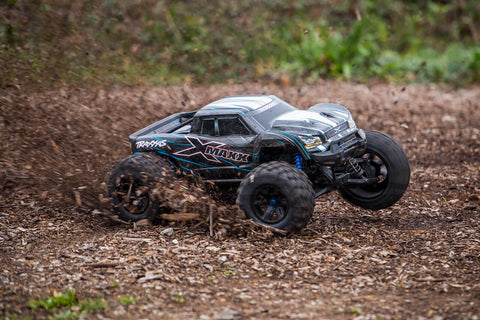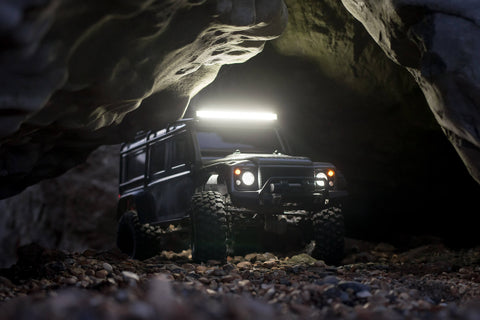The original Osmo Mobile provided the smooth video and intelligent operations modes found on its brother the Osmo, but designed for balancing a wide-range of smartphones. Over the years the competition have caught up with capable and (crucially) cheaper alternatives to the DJI device.
However following an anouncement at CES this year, DJI have returned with the Osmo Mobile 2. It not only builds on the original's feature-set, but comes in at a low price point, potentially exposing it to a new customer base. Following a couple of weeks testing we can finally share our experiences in using the new stabiliser.

 The unboxing experience lacks the premium feel of the older model and its the first hint you get that the device is being sold on a budget.
The unboxing experience lacks the premium feel of the older model and its the first hint you get that the device is being sold on a budget.
 Gone are the matt-black cardboard, individually packaged power adapters and soft-lined zipped carry case. They have been replaced with a larger Phantom4-style hard-polystyrene hinged-case that houses the gimbal itself (and perhaps offers better protection) a solitary micro-USB 'power' cable and the some lightweight warranty/instruction booklets.
Gone are the matt-black cardboard, individually packaged power adapters and soft-lined zipped carry case. They have been replaced with a larger Phantom4-style hard-polystyrene hinged-case that houses the gimbal itself (and perhaps offers better protection) a solitary micro-USB 'power' cable and the some lightweight warranty/instruction booklets.

 The new full-size usb output on the front is actually very useful for charging devices such as your phone. Be aware that you will need a slim right-angle cable to connect your device to the Osmo Mobile 2 if you intend to charge whilst filming (or simply flip your phone so the connector is facing outwards). Note that the gimbal needs to be powered up to feed your phone.
The new full-size usb output on the front is actually very useful for charging devices such as your phone. Be aware that you will need a slim right-angle cable to connect your device to the Osmo Mobile 2 if you intend to charge whilst filming (or simply flip your phone so the connector is facing outwards). Note that the gimbal needs to be powered up to feed your phone.


 Unscrew the metal adjuster pictured above to position the extention arm left and right across the roll axis until the device balances as shown below. Once balanced, the Osmo mobile (whilst powered down) should hold the smartphone horizontally without it rotating left or right.
Unscrew the metal adjuster pictured above to position the extention arm left and right across the roll axis until the device balances as shown below. Once balanced, the Osmo mobile (whilst powered down) should hold the smartphone horizontally without it rotating left or right.
 The majority of new smartphones have their charge ports in the base of the device, thus when mounted into the Osmo Mobile 2 they cannot be charged. Some users have suggested a workaround using a right angled USB charge cable but this then moves the centre of gravity further left than usual.
One of the big changes for the Osmo mobile 2 is the support for portrait orientation. Sadly its not just as case of twisting the phone into position when the system is live. The phone holder must be rotated 90° and this is achieved via the large metal adjustment knob on the back of the holder, unwind it and slowly click it round into position.
The majority of new smartphones have their charge ports in the base of the device, thus when mounted into the Osmo Mobile 2 they cannot be charged. Some users have suggested a workaround using a right angled USB charge cable but this then moves the centre of gravity further left than usual.
One of the big changes for the Osmo mobile 2 is the support for portrait orientation. Sadly its not just as case of twisting the phone into position when the system is live. The phone holder must be rotated 90° and this is achieved via the large metal adjustment knob on the back of the holder, unwind it and slowly click it round into position.
 As before, adjust the position of the smartphone and extension arm until the phone stays balanced with the gimbal powered down, just this time in portrait position.
As before, adjust the position of the smartphone and extension arm until the phone stays balanced with the gimbal powered down, just this time in portrait position.
 In our case, with the extension arm adjusted to minimum length, the phone still needed to be pushed further left to achieve a balance; Thankfully the actual phone clamp holder adjustment range allows for this as seen below.
In our case, with the extension arm adjusted to minimum length, the phone still needed to be pushed further left to achieve a balance; Thankfully the actual phone clamp holder adjustment range allows for this as seen below.
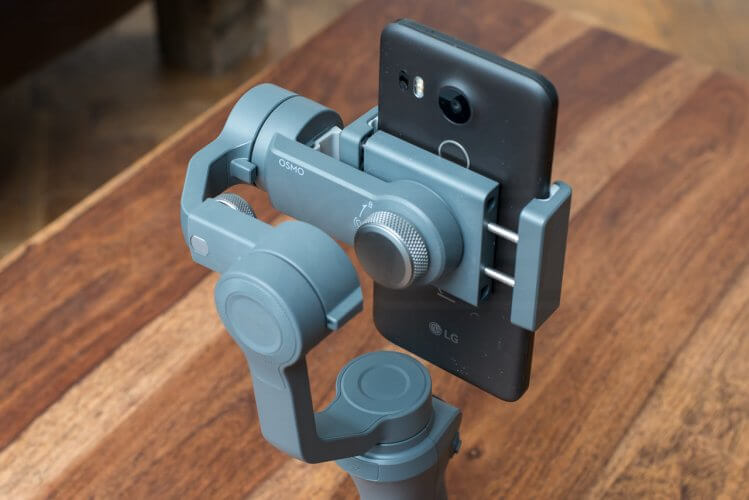 Many handsets have the volume and often the power buttons on the side of the device. Thankfully DJI have planned for this, the device holder including a groove down both sides of the holder to ensure clearance.
Many handsets have the volume and often the power buttons on the side of the device. Thankfully DJI have planned for this, the device holder including a groove down both sides of the holder to ensure clearance.
 The joystick is great for adjusting the position of the camera when in 'free' mode, allowing you to hold the gimbal directly out in-front of you like a torch. Note that the gimbal will still balance when inverted should you want a really low shot that raises like a crane.
The joystick is great for adjusting the position of the camera when in 'free' mode, allowing you to hold the gimbal directly out in-front of you like a torch. Note that the gimbal will still balance when inverted should you want a really low shot that raises like a crane.
 As with the original gimbal, you need to learn how to 'walk smoothly' to make the most from the Osmo due to its lack of 'z-axis' stabilisation.
As with the original gimbal, you need to learn how to 'walk smoothly' to make the most from the Osmo due to its lack of 'z-axis' stabilisation.
 But thanks to the latest version of the DJI Go smartphone app, the Osmo Mobile 2 has some incredible capabilities beyond this.
But thanks to the latest version of the DJI Go smartphone app, the Osmo Mobile 2 has some incredible capabilities beyond this.
 The tracking feature is ideal for vloggers. Using either the rear, or your front facing camera (triple tapping the mode button to swing the smartphone towards you, allowing you to review the footage in real time) the Osmo Mobile 2 will track your face to ensure it is always in shot, even when jogging. Note that the tracking feature also works with the timelapse mode, meaning you can easily create complex motion hyperlapse shots like below.
The tracking feature is ideal for vloggers. Using either the rear, or your front facing camera (triple tapping the mode button to swing the smartphone towards you, allowing you to review the footage in real time) the Osmo Mobile 2 will track your face to ensure it is always in shot, even when jogging. Note that the tracking feature also works with the timelapse mode, meaning you can easily create complex motion hyperlapse shots like below.
 Motionlapses are a favourite of many youtubers and sticking the Osmo Mobile 2 on a tripod (or resting it on a railing) makes this a breeze.
Motionlapses are a favourite of many youtubers and sticking the Osmo Mobile 2 on a tripod (or resting it on a railing) makes this a breeze.
 Slow motion videos always look much better with stabilisation. The DJI app does currently limit the slo-motion video size (or in the case of Android, not support it at all) and thus we recommend using your phone's built-in camera app when filming slow motion.
Slow motion videos always look much better with stabilisation. The DJI app does currently limit the slo-motion video size (or in the case of Android, not support it at all) and thus we recommend using your phone's built-in camera app when filming slow motion.
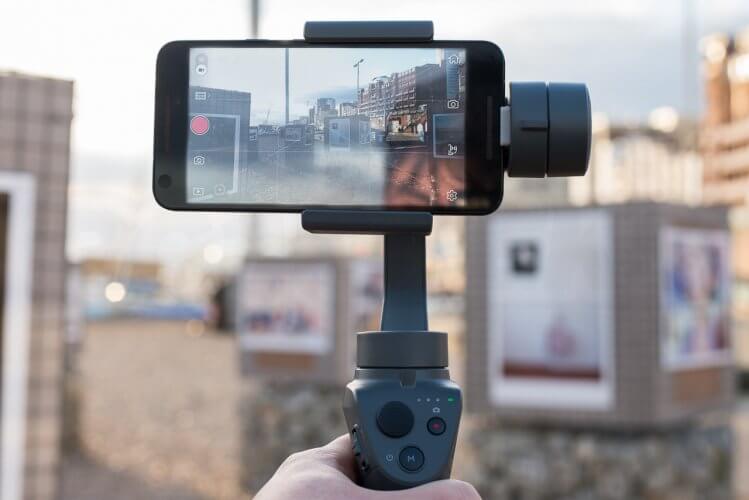
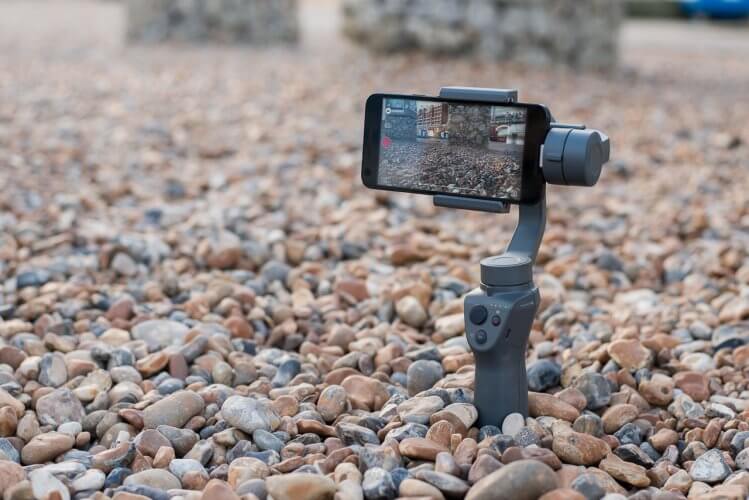

Osmo mobile 2 at a glance
- Now Just 485g
- 15 hour battery life (under ideal conditions) and charged again in 2 hours (max 2 Amp charge).
- USB power output (5v @ 1.5Amp) which can recharge your phone whilst in use.
- A metal 1/4inch tripod thread (standard size) in handle base.
- Revised Intelligent modes including Activetrack, Motionlapse, Zoom control and more.
Osmo Mobile 2 unboxing
 The unboxing experience lacks the premium feel of the older model and its the first hint you get that the device is being sold on a budget.
The unboxing experience lacks the premium feel of the older model and its the first hint you get that the device is being sold on a budget.
 Gone are the matt-black cardboard, individually packaged power adapters and soft-lined zipped carry case. They have been replaced with a larger Phantom4-style hard-polystyrene hinged-case that houses the gimbal itself (and perhaps offers better protection) a solitary micro-USB 'power' cable and the some lightweight warranty/instruction booklets.
Gone are the matt-black cardboard, individually packaged power adapters and soft-lined zipped carry case. They have been replaced with a larger Phantom4-style hard-polystyrene hinged-case that houses the gimbal itself (and perhaps offers better protection) a solitary micro-USB 'power' cable and the some lightweight warranty/instruction booklets.

What is new with the Osmo Mobile 2?
Lets look in detail at the changes with the new gimbal.Internal Battery
The 15 hour battery life is one of the highlights of the new Osmo mobile. Gone is the old 980mAh battery that offered around 4 hours life (under ideal conditions) and it is replaced with a 2600mAh battery with a claimed 15 hour lifespan. This is charged via the new micro-USB port on the right hand side of the handle, avoiding the bespoke DC Jack to USB cable nonsense of the original system. Above the record button the Osmo mobile now has 4 led indicators, one for power state and three showing the available battery life (also visible in the top right of the DJI Go App). The only downside to the new system that we can see is that it is no longer removable, (no more swapping out batteries in the field) so make sure you have a powerbank on hand. That said over along weekend of casual shooting (intermittent usage) we never ran out of juice. The new full-size usb output on the front is actually very useful for charging devices such as your phone. Be aware that you will need a slim right-angle cable to connect your device to the Osmo Mobile 2 if you intend to charge whilst filming (or simply flip your phone so the connector is facing outwards). Note that the gimbal needs to be powered up to feed your phone.
The new full-size usb output on the front is actually very useful for charging devices such as your phone. Be aware that you will need a slim right-angle cable to connect your device to the Osmo Mobile 2 if you intend to charge whilst filming (or simply flip your phone so the connector is facing outwards). Note that the gimbal needs to be powered up to feed your phone.
Hardware Controls
To turn on the Osmo Mobile 2 you need to short-press, then long press the mode button to power up. This is due to the removal of the power slider. Instead DJI have added a useful toggle slider to operate the zoom level of your smartphone, (no more pinching the screen) but it can be difficult to reach with smaller hands. Also gone is the popular front-mounted mode trigger (for switching between hold, follow and selfie modes) replaced by the aforementioned USB port. Mode switching is instead handled in a similar single, double or triple tap of the 'M' button at the bottom of the control panel. Retained are the textured joystick and the camera shutter button (for taking photos but also starting filming when in video mode). Overall the changes alter the way you interact with the system. Your thumb continues to be the primary control input, but now it is required to change mode and operate zoom is new ways that require more dexterity than the original device.
Tripod mount but no rosette
In a move likely to upset previous model owners, DJI has removed the rosette mount. If you used to rig your Osmo mobile up with a straight arm extention, or universal mount for your microphone and lights, then a new approach will be needed as your old mounting hardware is sadly redundant. Thankfully DJI have added a standard tripod screw thread into the base of the handle (where the battery door was in the orignal Osmo). This means it can be attached to a tripod, gorrilla pod or other rig mount without additional adaptors.Osmo Mobile Case
Gone is the zipped 'pencil' carry case for the new solid polystyrene block. Whilst it offers more protection you are going to need more space in your bag if you intend to carry this around.
Materials
The mass production of gimbal components and other steps taken toward manufacturing efficiencies have brought the price of the Osmo Mobile 2 down. Alas the decisions made on materials choices (plus the race to make it lighter to reduce fatigue in use) has made the device feel a lot cheaper. Gone is the rubberised handle grip that ensured it remained secure in your hand, the entire unit is made from hard plastic, textured on the hand holds and decorated on the motor caps.Price
However all of this means the new retail price has dropped from (over) £220, to a release price of just £130. This places it in a much stronger position against its competitors and opens it up to a wider consumers audience.Balancing Osmo 2 Mobile for Horizontal and Portrait
Whilst the motors in the gimbal are powerful, it is important to achieve a good balance to maximise the battery life of the stabiliser. Note : The DJI Osmo Mobile 2 will not actively stabilise until the device has been activated through the DJI Go app. Do not fear that your gimbal is broken, simply follow the instructions. The Osmo mobile 2 smartphone comes orientated for the standard horizontal mounting. Push the base of the phone up against the pad connected to the tilt motor before pulling the padded phone holder clamp arms apart to insert your phone. Unscrew the metal adjuster pictured above to position the extention arm left and right across the roll axis until the device balances as shown below. Once balanced, the Osmo mobile (whilst powered down) should hold the smartphone horizontally without it rotating left or right.
Unscrew the metal adjuster pictured above to position the extention arm left and right across the roll axis until the device balances as shown below. Once balanced, the Osmo mobile (whilst powered down) should hold the smartphone horizontally without it rotating left or right.
 The majority of new smartphones have their charge ports in the base of the device, thus when mounted into the Osmo Mobile 2 they cannot be charged. Some users have suggested a workaround using a right angled USB charge cable but this then moves the centre of gravity further left than usual.
One of the big changes for the Osmo mobile 2 is the support for portrait orientation. Sadly its not just as case of twisting the phone into position when the system is live. The phone holder must be rotated 90° and this is achieved via the large metal adjustment knob on the back of the holder, unwind it and slowly click it round into position.
The majority of new smartphones have their charge ports in the base of the device, thus when mounted into the Osmo Mobile 2 they cannot be charged. Some users have suggested a workaround using a right angled USB charge cable but this then moves the centre of gravity further left than usual.
One of the big changes for the Osmo mobile 2 is the support for portrait orientation. Sadly its not just as case of twisting the phone into position when the system is live. The phone holder must be rotated 90° and this is achieved via the large metal adjustment knob on the back of the holder, unwind it and slowly click it round into position.
 As before, adjust the position of the smartphone and extension arm until the phone stays balanced with the gimbal powered down, just this time in portrait position.
As before, adjust the position of the smartphone and extension arm until the phone stays balanced with the gimbal powered down, just this time in portrait position.
 In our case, with the extension arm adjusted to minimum length, the phone still needed to be pushed further left to achieve a balance; Thankfully the actual phone clamp holder adjustment range allows for this as seen below.
In our case, with the extension arm adjusted to minimum length, the phone still needed to be pushed further left to achieve a balance; Thankfully the actual phone clamp holder adjustment range allows for this as seen below.
 Many handsets have the volume and often the power buttons on the side of the device. Thankfully DJI have planned for this, the device holder including a groove down both sides of the holder to ensure clearance.
Many handsets have the volume and often the power buttons on the side of the device. Thankfully DJI have planned for this, the device holder including a groove down both sides of the holder to ensure clearance.
Osmo Mobile 2 In Use
Having started with Feiyutech phone gimbals years ago, we were impressed when the first Osmo mobile was released. It required minimal balancing and its companion app meant complete novices could begin shooting in no time. This trend has continued with a quick startup process. The Osmo continues to use Bluetooth to connect to your smartphone. Connection is simple as the device appears in an in-app list of devices available when first selecting the device in DJI Go. As stated before, the gimbal will not power up balance your smartphone until the activation process is complete. The primary use for many will be for simply stabilising video shots and for this the follow mode (double tap) is great. The joystick is great for adjusting the position of the camera when in 'free' mode, allowing you to hold the gimbal directly out in-front of you like a torch. Note that the gimbal will still balance when inverted should you want a really low shot that raises like a crane.
The joystick is great for adjusting the position of the camera when in 'free' mode, allowing you to hold the gimbal directly out in-front of you like a torch. Note that the gimbal will still balance when inverted should you want a really low shot that raises like a crane.
 As with the original gimbal, you need to learn how to 'walk smoothly' to make the most from the Osmo due to its lack of 'z-axis' stabilisation.
As with the original gimbal, you need to learn how to 'walk smoothly' to make the most from the Osmo due to its lack of 'z-axis' stabilisation.
 But thanks to the latest version of the DJI Go smartphone app, the Osmo Mobile 2 has some incredible capabilities beyond this.
But thanks to the latest version of the DJI Go smartphone app, the Osmo Mobile 2 has some incredible capabilities beyond this.
 The tracking feature is ideal for vloggers. Using either the rear, or your front facing camera (triple tapping the mode button to swing the smartphone towards you, allowing you to review the footage in real time) the Osmo Mobile 2 will track your face to ensure it is always in shot, even when jogging. Note that the tracking feature also works with the timelapse mode, meaning you can easily create complex motion hyperlapse shots like below.
The tracking feature is ideal for vloggers. Using either the rear, or your front facing camera (triple tapping the mode button to swing the smartphone towards you, allowing you to review the footage in real time) the Osmo Mobile 2 will track your face to ensure it is always in shot, even when jogging. Note that the tracking feature also works with the timelapse mode, meaning you can easily create complex motion hyperlapse shots like below.
 Motionlapses are a favourite of many youtubers and sticking the Osmo Mobile 2 on a tripod (or resting it on a railing) makes this a breeze.
Motionlapses are a favourite of many youtubers and sticking the Osmo Mobile 2 on a tripod (or resting it on a railing) makes this a breeze.
 Slow motion videos always look much better with stabilisation. The DJI app does currently limit the slo-motion video size (or in the case of Android, not support it at all) and thus we recommend using your phone's built-in camera app when filming slow motion.
Slow motion videos always look much better with stabilisation. The DJI app does currently limit the slo-motion video size (or in the case of Android, not support it at all) and thus we recommend using your phone's built-in camera app when filming slow motion.

Our take on the Osmo Mobile 2
We Like
- The price. Finally it is actually affordable for casual users.
- The USB charging (use it as a powerbank)
- The metal tripod thread
- Extended runtime thanks to the new motors and larger battery. The old battery life was frustratingly poor!
We don't like
- The slightly clumsy method required to move the phone from portrait to landscape. In an ideal world you would just reorientate the phone with your hands, tap a button and have it reset the base position.
- Non-user-replaceable battery. No swapping out the battery for a charged one like the old system, although you could of course plug in a powerbank.
- Limitation in the pan axis, whilst Zhiyun's now much older 'Smooth Q' is capable of full 360° rotation.







